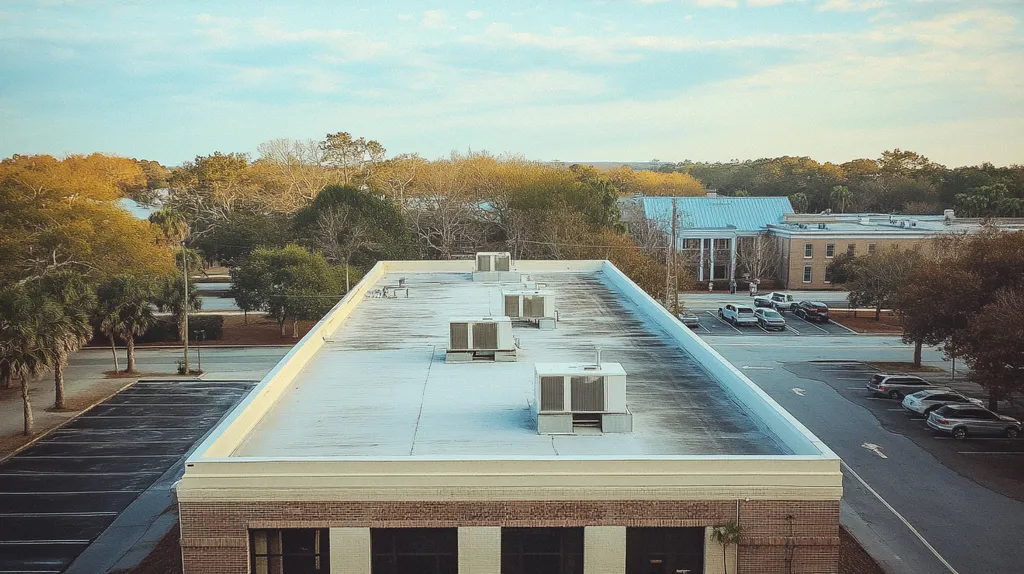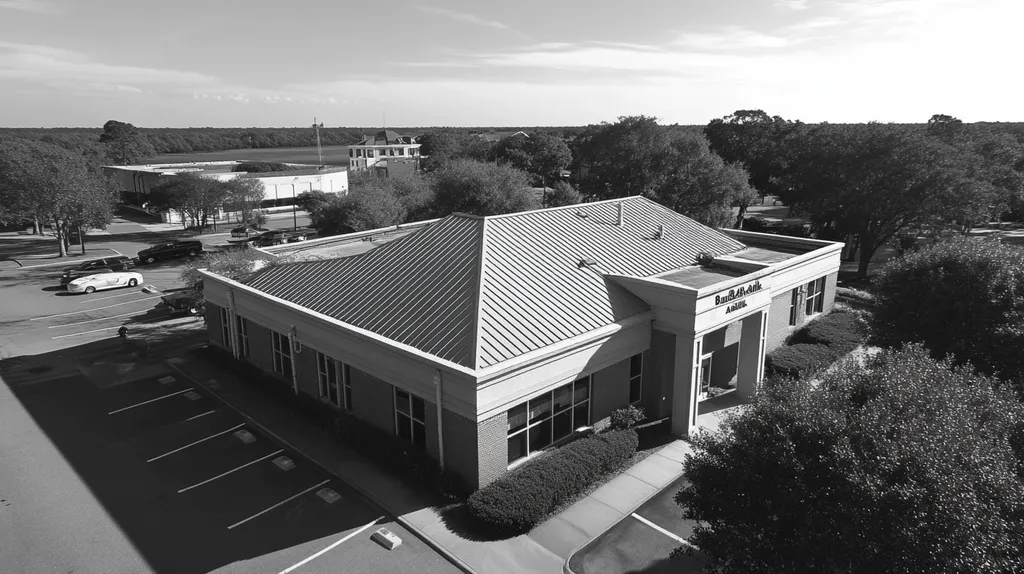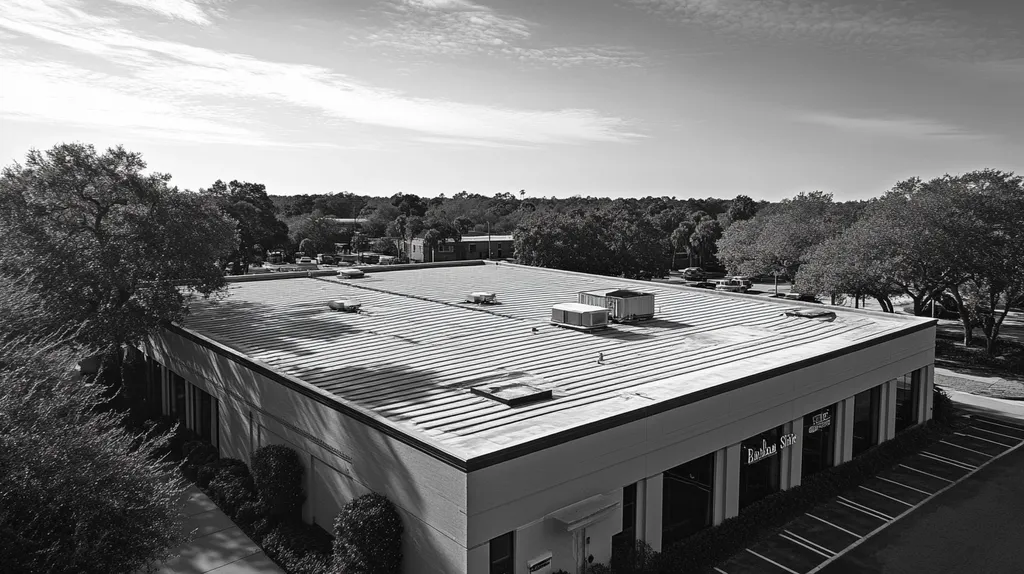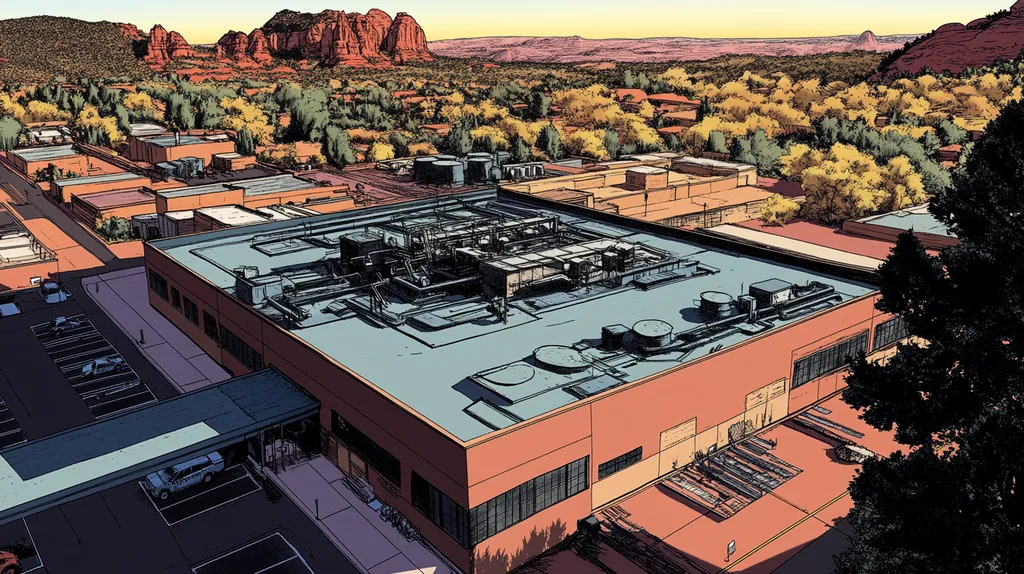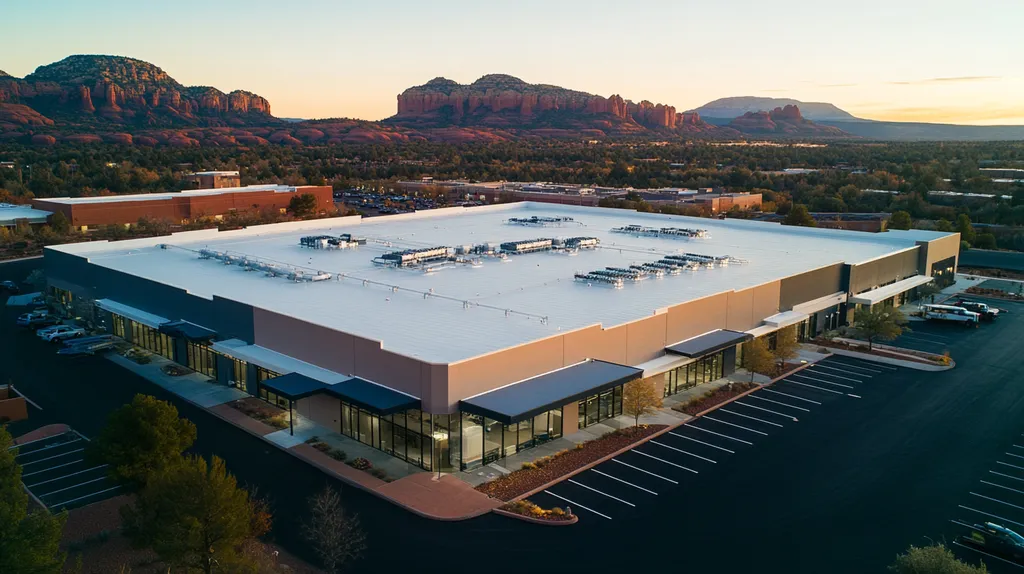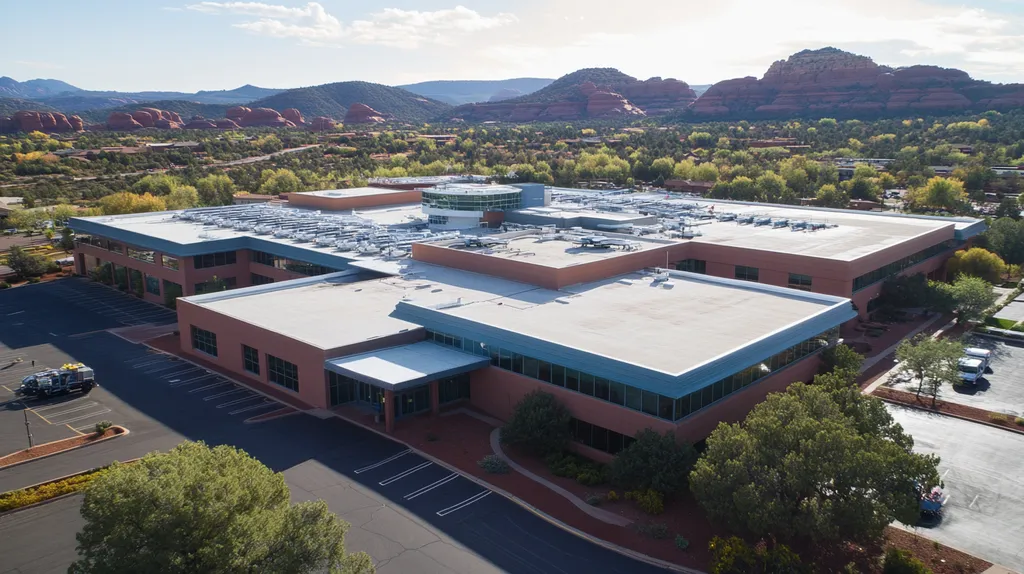Industrial roof repairs cost facilities an average of $7-12 per square foot, with unplanned disruptions adding up to 40% in unexpected expenses and lost productivity. For a typical 50,000-square-foot facility, poor repair planning can result in losses exceeding $250,000.
Managing these repairs effectively requires a strategic approach focused on performance, compliance, and risk mitigation. Property owners and facility managers must balance urgent maintenance needs with operational continuity.
This comprehensive guide provides actionable solutions for minimizing disruption during industrial roof repairs, addressing critical factors from material selection to scheduling optimization.
SECTION 1: PERFORMANCE FACTORS
Roof repairs are essential yet can be a major source of disruption for industrial facilities. Research indicates that prolonged repair activities can lead to a productivity drop of over 30%. To minimize these interruptions effectively, property owners and facility managers should concentrate on three vital performance factors: assessing roof integrity, evaluating the impact on operations, and selecting appropriate repair materials. By approaching these elements strategically, facilities can ensure repairs are executed efficiently and with minimal disruption.
Assessing Roof Integrity and Structural Soundness
Before beginning repairs, it’s crucial to thoroughly understand the roof’s condition. A comprehensive inspection reveals any weaknesses, such as leaks or structural damage, which, if overlooked, can lead to costly delays during the repair process.
Reliable assessments often employ advanced technologies like infrared thermography and moisture scanning. These methods provide precise insights into the roof’s state, enabling informed decisions that can save both time and resources.
Additionally, assessing the roof’s structural integrity is vital to ensure it can safely support repair activities and personnel. This foresight mitigates safety risks and minimizes potential disruptions to ongoing operations.
Key Action Items
Evaluating Repair Impact on Facility Operations
The scope of roof repairs can have a direct effect on an industrial facility’s workflow and productivity. Property owners should assess how these repairs might disrupt operations or employee safety. For example, extensive repairs might require temporary relocations of staff or equipment.
Effective communication with department heads and employees is vital for minimizing frustrations associated with disruptions. Keeping everyone informed about timelines and repair scopes can enhance cooperation and adaptability throughout the process.
Furthermore, the impact on crucial machinery and environmental controls is a significant consideration. For facilities that depend on specific temperature or environmental conditions, planning repairs to avoid upsetting these parameters is essential. Employing protective barriers around sensitive machinery during work can help maintain necessary operations.
Key Action Items
Selecting Fast-Curing and Low-Impact Materials
The choice of repair materials is instrumental in reducing downtime during roof repairs. Fast-curing materials facilitate quicker application and shorten the recovery period, allowing facilities to resume normal operations sooner. For example, using quick-setting adhesives can significantly speed up repair times.
Additionally, opting for low-impact materials minimizes disturbances to the facility environment. They often require less heavy machinery, thereby reducing noise and debris typically associated with repairs. Such selections underscore a commitment to maintaining a productive work atmosphere.
Moreover, it’s wise to consider materials that bolster energy efficiency and promote sustainability. These choices not only improve the roof’s performance but also align with broader corporate responsibility goals. Facilities that invest in eco-friendly solutions not only reap long-term savings but also enhance their reputation among stakeholders.
Key Action Items
SECTION 2: FINANCIAL CONSIDERATIONS
Effective roof repairs are vital for keeping industrial facilities running smoothly, but the associated financial implications can be considerable. Unplanned downtime may cost businesses over $5,000 per hour, making it essential to wisely plan repair budgets, conduct cost-benefit analyses, and schedule repairs strategically. This section will delve into financial strategies that assist in managing roof repairs without causing significant disruption.
Budgeting for Repairs with Minimal Operational Disruption
To manage roof repairs efficiently, it is crucial to budget effectively while considering potential costs and minimizing disruptions. Facility managers should take into account both direct costs, like materials and labor, and indirect costs, such as productivity losses during repairs.
Utilizing historical data enables property owners to draft a detailed budget that supports swift decision-making when issues arise. Allocating emergency repair funds within the budget ensures that urgent problems can be addressed promptly.
Moreover, investing in preventive maintenance can reduce the need for costly emergency repairs down the line. This proactive stance not only saves money but also keeps operations uninterrupted.
Key Action Items
Cost-Benefit Analysis of Rapid Repair Technologies
Rapid repair technologies can provide substantial cost savings for industrial facilities when evaluated properly. Decision-makers should carefully compare initial investment costs to the long-term benefits these technologies offer.
For example, roofing systems utilizing spray polyurethane foam (SPF) allow for quick installation and enhanced insulation, resulting in reduced energy expenses and faster repairs. The initial outlay often leads to savings in energy costs and downtime.
Furthermore, advanced repair solutions typically extend the lifespan of roofing systems, reducing the need for repeated repairs and ultimately enhancing financial performance. Conducting a detailed cost-benefit analysis allows for better appreciation of the financial returns on these innovative repair technologies.
Key Action Items
Scheduling Repairs to Optimize Financial Performance
Strategically scheduling repairs is key to minimizing their financial impact. Conducting repairs during off-peak times can help reduce operational disruptions and improve safety for all involved.
Awareness of the facility’s business cycle allows managers to align repair work with slower periods, protecting revenue and reducing interruptions. This foresight plays a crucial role in maintaining a stable workflow.
Additionally, synchronizing repairs with routine maintenance tasks can result in further cost savings, as multiple issues can be resolved at once. Clear communication about the repair schedule effectively manages expectations and helps maintain productivity throughout the process.
Key Action Items
SECTION 3: COMPLIANCE REQUIREMENTS
In the realm of industrial roofing, adherence to compliance standards is crucial—not optional. Falling short of safety regulations and building codes can incur substantial legal penalties and financial repercussions, with OSHA violations potentially costing over $13,000 per incident. Understanding the compliance landscape is vital for minimizing disruption during repairs, encompassing a few key focus areas.
Ensuring OSHA and Safety Regulations During Repairs
OSHA regulations establish high benchmarks for workplace safety, particularly in the roofing sector. Key aspects include safe scaffolding practices, fall protection measures, and the use of personal protective equipment (PPE). Employers must prioritize training and equipping their workers effectively to mitigate safety risks during repair activities.
Conducting comprehensive risk assessments before initiating repairs is essential. This proactive measure identifies hazards and formulates necessary safety protocols. Regular safety meetings can reinforce compliance throughout the repair process and ensure all employees remain vigilant about safety practices.
Neglecting safety regulations not only jeopardizes employee well-being but can also lead to significant delays in repair timelines. Fostering a culture of compliance is vital for maintaining workflows and protecting workers. Utilizing technology such as drones for inspections or real-time safety monitoring applications can also enhance compliance and overall operational efficiency.
Key Action Items
Meeting Building Codes for Industrial Roofing Work
Building codes play a critical role in ensuring that roofing work meets established standards for safety and structural integrity. Compliance with these codes is vital for avoiding costly rework and ensuring minimal disruption during repairs.
Before launching into repairs, it’s important to consult with local building authorities to fully understand applicable codes. Partnering with a licensed roofing contractor who is well-versed in these regulations can save time and streamline the repair process. This ensures that the materials and methods used comply with required specifications.
Non-compliance may result in hefty fines and could even necessitate project delays or demolitions. By prioritizing adherence to building codes, facilities can enhance the longevity of their roofs and protect their investments. Implementing regular audits and third-party inspections can further uphold compliance standards.
Key Action Items
Documenting Compliance and Inspection Protocols
Thorough documentation is indispensable for demonstrating adherence to compliance standards and for mitigating potential liabilities. Maintaining accurate records of safety measures, employee training, and inspection outcomes is essential for transparency and verifiability.
Implementing a robust system for tracking compliance metrics can help identify areas needing attention. Routine reviews of safety protocols and documentation foster accountability within the organization and ensure ongoing adherence to safety standards.
Engaging third-party firms for independent audits can provide valuable insights and highlight compliance gaps, offering actionable recommendations for improvement. A well-maintained documentation process not only ensures compliance but also contributes to seamless future repairs and preserves the facility’s reputation.
Key Action Items
SECTION 4: RISK MANAGEMENT
Industrial roof repairs pose serious safety risks that can result in costly accidents and project delays. Slips, trips, and falls, as identified by the Occupational Safety and Health Administration (OSHA), rank among the top causes of workplace injuries. Therefore, understanding and addressing safety hazards is essential for protecting workers and ensuring continuous operations. This section emphasizes effective risk management strategies designed specifically for industrial facilities to mitigate disruptions during roof repairs.
Identifying Safety Hazards and Mitigation Strategies
Effective risk management starts with identifying potential safety hazards. Common dangers during roof repairs include working at heights, equipment exposure, and adverse weather conditions. Conducting thorough site assessments prior to repairs helps pinpoint these risks and develop effective mitigation strategies.
Installing guardrails and using harness systems can greatly diminish fall hazards. Engaging certified professionals trained in safety protocols ensures all crew members are aware of risks associated with their tasks. This protective culture enhances worker safety and reduces the chance of accidents, leading to fewer disruptions.
Providing proper safety gear, such as helmets and anti-slip footwear, further safeguards workers. Regular training sessions keep staff updated on best practices and protocols, reinforcing the importance of hazard identification and mitigation. When safety is prioritized, facilities can better protect their workforce and ensure repairs stay on track.
Key Action Items
Emergency Response Planning for Unexpected Failures
No matter how meticulous the planning, unforeseen failures can arise during roof repairs, making emergency response planning crucial. Industrial facilities must have a well-defined emergency plan that specifies immediate actions in case of accidents or sudden repair complications.
This includes setting up communication channels for emergencies, such as contact lists for safety officers and medical services. Conducting regular drills ensures that all employees know the protocol and can respond quickly when a crisis arises.
Having a designated safe zone for workers during emergencies helps maintain order. This area should be easily accessible and stocked with first-aid supplies and communication devices. Clear roles and responsibilities during emergencies reduce confusion and facilitate safe evacuations, ensuring personnel safety.
Key Action Items
Controlling Environmental and Health Risks During Repairs
Managing environmental and health risks during roof repairs is vital for worker safety and regulatory compliance. Exposure to hazardous materials, like asbestos, can have serious health consequences and lead to significant legal issues.
Performing environmental assessments before starting repairs ensures compliance with regulations and highlights potential hazards. Facilities need to ensure proper ventilation and employ protective gear when dealing with hazardous substances.
Using environmentally-friendly materials not only mitigates health risks but also strengthens the facility’s reputation. Choosing low-emission roofing materials minimizes harmful emissions during repairs, helping facilities meet their sustainability targets while maintaining health and safety.
Key Action Items
SECTION 5: OPERATIONAL PROCEDURES
In industrial facilities, roofing repairs can significantly impact operations if not meticulously organized. The National Roofing Contractors Association highlights that uncoordinated repair projects often lead to production delays, revenue loss, and safety hazards. Establishing clear operational procedures is vital for minimizing these adverse effects. Essential considerations include scheduling work during off-peak hours, effectively communicating with stakeholders, and implementing robust safety protocols.
Developing Work Schedules During Off-Peak Hours
Strategically scheduling repairs during off-peak hours is a proactive method to minimize operational disruptions. Many facilities see peak production times when noise and activity from repair work can interfere with routine tasks. Conducting repairs during evenings or weekends can effectively avoid this interference.
For instance, a manufacturing plant might plan roof repairs to start on Friday evenings, targeting completion by early Monday morning. This approach keeps critical processes on track while providing adequate time for repairs, minimizing disruption.
Additionally, utilizing project management software can aid in creating detailed schedules, tracking progress, and ensuring that repair work overlaps minimally with essential operations. Flexible, trained work crews can also help expedite repair tasks, further reducing time spent on-site.
Key Action Items
Communicating Repair Plans to Stakeholders Effectively
Clear and proactive communication with all stakeholders is essential for a smooth repair process. Property owners and facility managers must ensure that employees, suppliers, and clients are well-informed about the repair details, including timing and scope. Poor communication can lead to confusion and unexpected interruptions.
Structured updates delivered through emails, newsletters, or meetings should outline the timeline and potential impacts on operations. For example, establishing a dedicated platform for real-time updates can aid in addressing questions and minimizing anxiety among staff.
Moreover, creating a visual timeline can help stakeholders track project progress and understand how repairs will influence their roles. Such transparency fosters cooperation and promotes a collective effort in managing the repair project effectively.
Key Action Items
Implementing Site Safety and Access Controls
Prioritizing safety during roofing projects is critical. Implementing site access controls ensures a secure environment for both repair teams and facility personnel. Restricting access to designated areas minimizes the chance of unauthorized entry and potential accidents.
Clearly marked zones with appropriate signage help direct foot traffic safely, and assigning staff to monitor these areas reinforces adherence to safety protocols. Regular safety drills and training sessions prepare employees to respond effectively to emergencies.
Moreover, providing personal protective equipment (PPE) that complies with safety regulations is essential. Equipping all team members with the necessary safety gear protects their well-being and enhances compliance during the roofing repairs.
Key Action Items
SECTION 5: OPERATIONAL PROCEDURES
In industrial facilities, poorly organized roofing repairs can cause major disruptions. The National Roofing Contractors Association reports that uncoordinated projects may lead to production delays, lost revenue, and safety hazards. Establishing clear operational procedures is crucial to mitigate these issues. Key considerations include scheduling work during off-peak hours, effectively communicating with stakeholders, and enforcing strict safety measures.
Developing Work Schedules During Off-Peak Hours
Scheduling repairs during off-peak hours is a strategic move to minimize disruptions in industrial operations. Many facilities experience peak production times that conflict with noisy and active roofing work. Conducting repairs during evenings or weekends can effectively address these concerns.
For instance, a manufacturing plant might schedule roof repairs to begin Friday evenings, targeting completion before early Monday morning. This thoughtful planning keeps essential activities uninterrupted while allowing sufficient time for repairs.
Moreover, leveraging project management software can aid in creating and monitoring detailed schedules, tracking progress, and minimizing overlap with critical operations. Additionally, training flexible work crews for rapid response can help accelerate repair tasks, further reducing on-site time.
Key Action Items
Communicating Repair Plans to Stakeholders Effectively
Effective communication with all stakeholders is essential for a smooth repair process. Property owners and facility managers must inform employees, suppliers, and clients about repair details, including timing and scope. Insufficient communication can result in confusion, frustration, and unplanned interruptions.
Structured updates should be disseminated through emails, newsletters, or meetings, outlining the scope of work, expected timelines, and potential impacts on operations.
Implementing a dedicated communication platform can facilitate real-time updates and allow employees to ask questions. This proactive approach alleviates anxiety and nurtures cooperation.
Key Action Items
Implementing Site Safety and Access Controls
Safety must be prioritized during any industrial roofing project. Implementing site access controls is vital for maintaining a secure environment for repair teams and facility personnel. Restricting access to designated areas reduces unauthorized entry and minimizes accident risks.
Establishing clearly marked zones with appropriate signage directs foot traffic safely, while assigning staff to monitor these areas ensures adherence to safety protocols. Regular safety drills and training prepare all employees for emergencies, enhancing their ability to respond effectively.
Furthermore, providing personal protective equipment (PPE) in compliance with safety regulations is essential. Ensuring all team members are equipped with necessary safety gear safeguards them from potential roofing hazards during repairs.
Key Action Items
The Bottom Line
Industrial roof repairs represent a significant operational and financial challenge, with poorly managed projects increasing costs by up to 40% and disrupting productivity for weeks or months.
Success requires careful orchestration of performance factors, financial considerations, compliance requirements, risk management protocols, and operational procedures.
By implementing proactive maintenance schedules, utilizing rapid-repair technologies, and following strict safety protocols, facilities can reduce repair-related disruptions by over 60%.
The key is developing comprehensive action plans that prioritize minimal disruption while maintaining structural integrity and workplace safety.
With industrial roof replacement costs averaging $7-12 per square foot, the stakes are too high to ignore proper planning and execution of repair projects.
FREQUENTLY ASKED QUESTIONS
Q. How can I assess industrial roof integrity?
A. A thorough inspection of the roof is essential. Utilize technologies like infrared thermography to identify leaks and structural weaknesses. Document findings meticulously for effective planning of repair actions.
Q. What are the financial impacts of unplanned commercial roof repairs?
A. Unplanned repairs can cost businesses significantly in both direct losses and indirect productivity decreases. Effective budgeting and cost-benefit analysis can mitigate these expenses, ensuring minimal downtime.
Q. How can I ensure compliance with roofing regulations?
A. Consult local building authorities and hire licensed contractors who understand applicable regulations. Regular audits and adherence to safety standards can help maintain compliance and avoid penalties.
Q. What safety hazards should I consider during roofing work?
A. Identify hazards like working at heights and equipment exposure. Implement proper safety protocols, utilize protective equipment, and engage trained professionals to mitigate risks effectively.
Q. How should I schedule repairs to minimize disruption?
A. Schedule repairs during off-peak hours to limit impact on operations. Utilizing project management software can streamline scheduling and help complete repairs promptly while maintaining productivity.
Q. What should be included in an emergency response plan?
A. A comprehensive plan should include communication protocols, emergency contacts, and a designated safe zone. Regular drills ensure everyone knows the protocol, enhancing responsiveness during crises.
Q. What materials are best for reducing noise during roof repairs?
A. Opt for low-impact materials that produce less noise and disturbance. Acoustic insulation can also be integrated to minimize noise during repairs, preserving a productive work environment.

